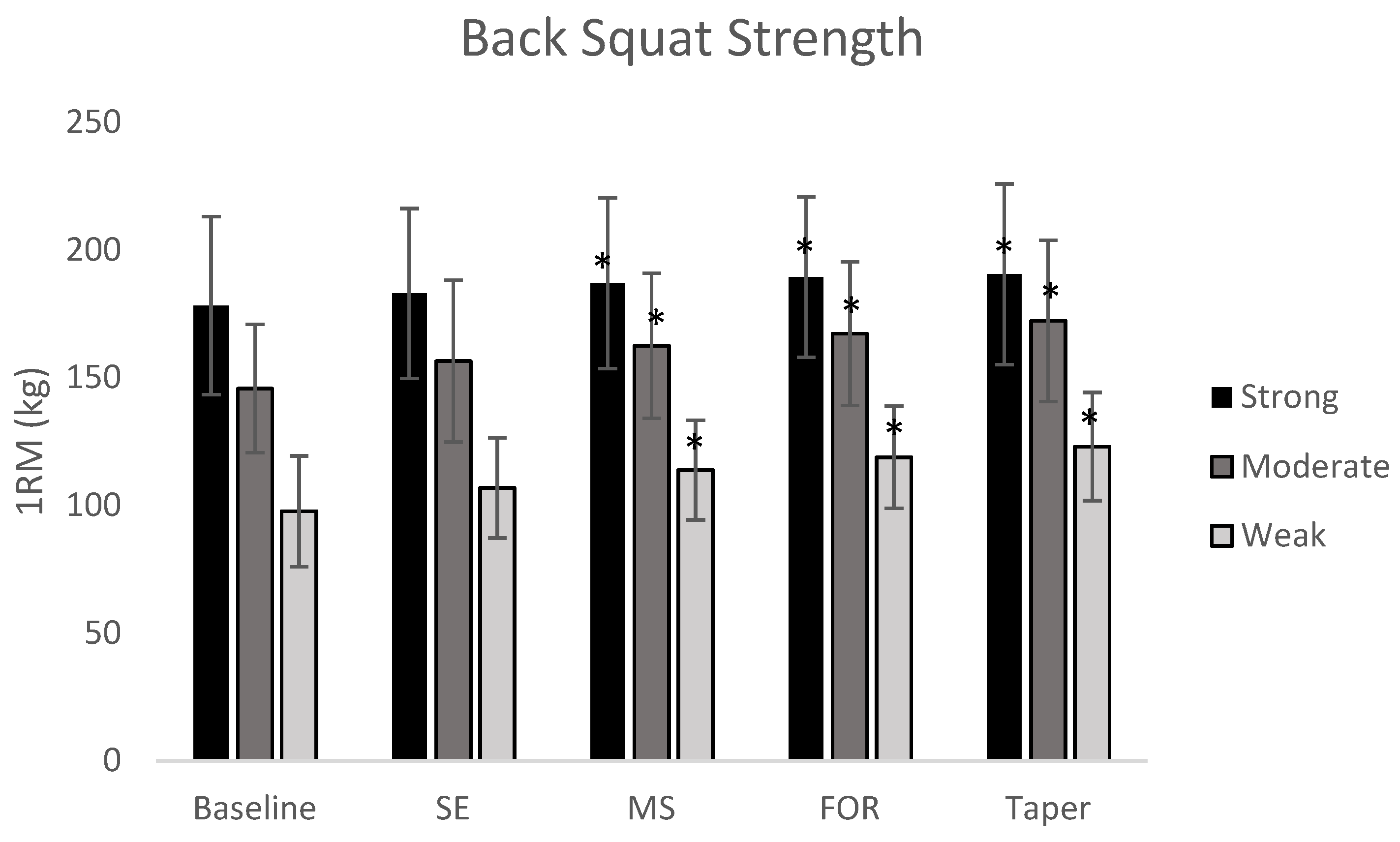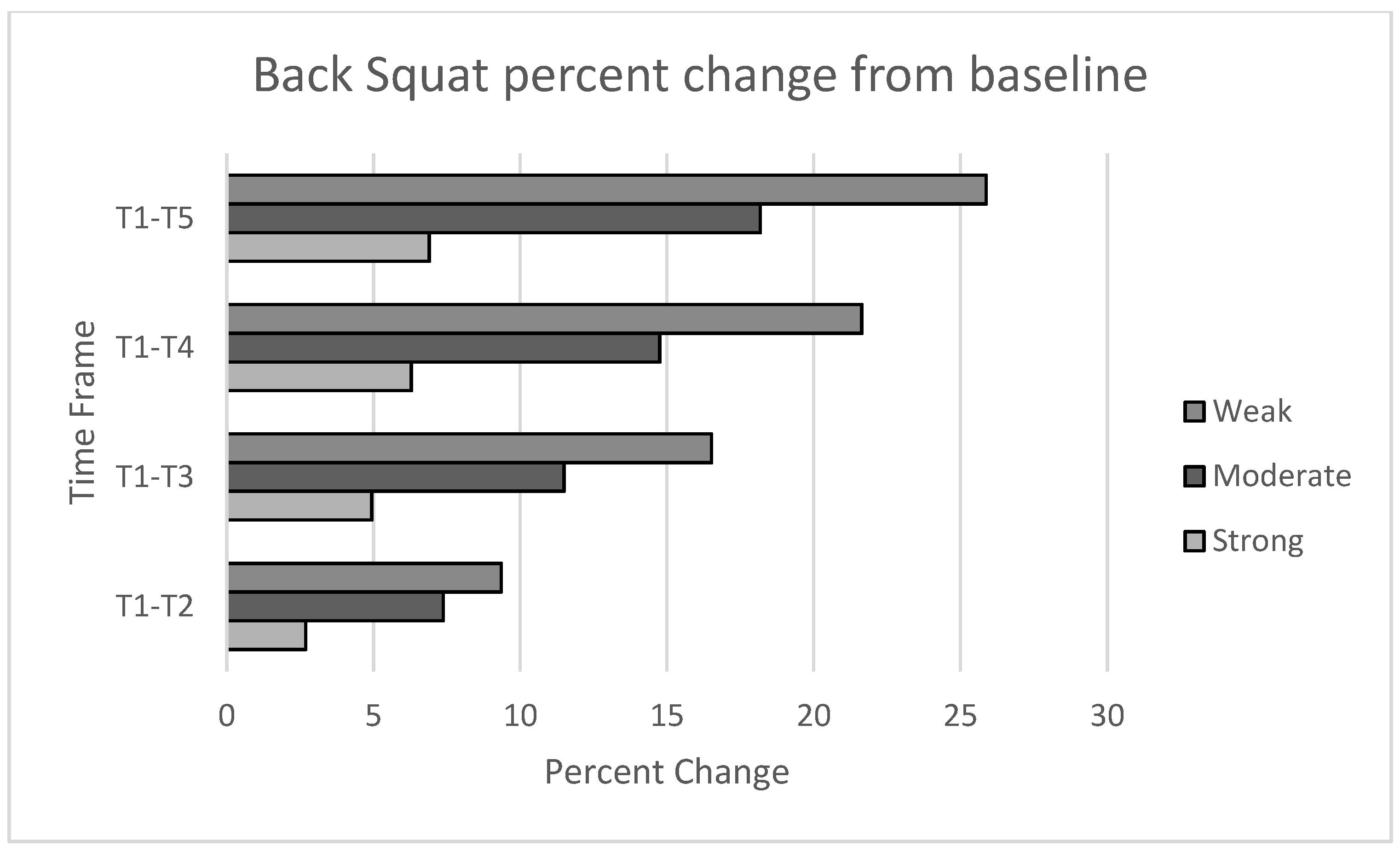1. Introduction
Controversy exists as to the most efficacious method of training to achieve enhanced levels of sport performance characteristics, especially as it pertains to strength and power [
1,
2,
3]. The majority of reviews of the literature [
4,
5,
6,
7,
8,
9,
10,
11] including several meta-analyses [
10,
11] have consistently concluded that a “periodized” training concept offers advantages over non-periodized processes.
However, some controversy concerning the periodization models exists [
11]. There are only two models of periodization, Traditional (Classic) and Block [
4,
12]. Traditional periodization allows for simultaneous alterations in a variety of fitness characteristics, whereas single factor block periodization takes a more consecutive approach in which one or a few compatible characteristics are developed before emphasizing a different set of characteristics [
5,
6,
12].
Much of this controversy stems from confusion of periodization with programming [
4]. It should be noted that periodization is a conceptual paradigm that deals with (1) Fitness phases and (2) Time lines for implementation of the fitness phases. There are two basic (general) premises of the periodization concept: (1) less specific to more specific and (2) higher volume to lower volume [
5,
6,
13]. Based on past [
14,
15], and particularly recent evidence [
13,
16,
17], it is becoming increasingly clear that Block Periodization provides superior results when properly programmed.
Briefly Simple Block periodization consist of three primary phases, Accumulation (general preparation), Transmutation (special preparation), and Realization (competition and taper). Periodization is supported mechanistically by several basic hypotheses/theories of describing an organism’s reaction to a specific stimulus [
4,
12]. These conceptual mechanisms include stimulus-fatigue-recovery adaptation, the general adaptation syndrome (GAS) and specifically for strength power training development of hypertrophy, then basic strength then power [
4,
12,
18,
19].
Much of the controversy concerning the efficacy of periodization and especially block periodization likely stems from the use of trained versus poorly or untrained subjects and the use of programming techniques used to drive the periodization model [
4]. For example: recently Painter et al. [
16,
17], and particularly Carroll et al. [
13], have provided evidence that training to failure using RM zones may inhibit gains in maximum strength, rate of force development (RFD) and power. Compared to non-failure, training to failure can produce a relatively high degree of training monotony and strain that is reflected to greater extent in negative physiological/metabolic responses (e.g., testosterone, cortisol, neutrophil: leucocyte ratios, etc.). This negative aspect of adaptation noted with training to failure is also in agreement with recent studies indicating an extended recovery necessary for training to failure [
20,
21,
22]. Extended recovery may inhibit adaptation or potentiate non-functional overreaching or overtraining [
13,
17], particularly when applied to a sport environment with other training in addition to the resistance program.
Training level may be a major influence on training outcomes as (1) untrained subjects using the same stimulus tend to gain strength at a faster rate than trained [
10,
23]; (2) previous training producing increased maximum strength may potentiate further gains in power when power training is emphasized [
24,
25,
26]; (3) training combinations using a strength plus power emphasis can potentiate both strength and power gains [
4,
12], and (4) initial gains in hypertrophy may be due to changes in edema and swelling [
27]. Thus, the purpose of this study is to study the effect of training status on adaptation to block periodization resistance training.
4. Discussion
The vast majority of existing reviews of the literature [
5,
6,
7,
8,
9,
10,
11] and several meta-analyses [
10,
11,
33], have consistently concluded that a “periodized” training concept offers advantages over non-periodized processes. The results of our current study support the previous literature in the effectiveness of a periodized program in enhancing maximum strength and power. The sequential programming approach used within BP has also been termed phase-potentiation [
15]. Phase potentiation programming is a process by which programming alterations in a concentrated load in one block may further potentiate the adaptations in the subsequent blocks due to accumulated residual training effects [
5,
6] Power, along with impulse, has previously been defined as a most important attribute for athletic performance [
15]. As noted in the introduction, development of maximal strength may potentiate further gains in power. Our results support this theory as subjects realized early gains in strength after the SE and MS blocks which led to large improvements in jump height and PP during the taper. It should be noted however, the strong group generally realized the greatest gains as a result of the taper (
Table 6). These results, particularly for the strong group, are indicative of the shift in emphasis over a BP program from general strength endurance towards realizing maximum strength and power in the later phases of training, along with a volume reduction. Similar results have been found previously by Carroll et al., (2018) who employed a very similar BP training program. In their results, subjects substantially improved their scaled PP from pre to post (
p = 0.003) as well as during the final phase of the program (taper) (
p = 0.026) [
13]. Our current findings along with previous findings support the efficacy of a BP model for maximizing strength and power, especially in the later phases of training.
The results of this study highlight the importance of training status on adaptation to a training stimulus. Statistically significant correlations were found between initial strength levels (both absolute and relative) and improvement in strength (absolute and relative) over time. Specifically, strong negative correlations were found between initial strength levels and percent change in maximum strength and vertical jump ability indicating that weaker individuals improve at a greater rate than stronger individuals. These results are supported by those of Ahtiainen et al. (2003) who compared strength athletes and non-athletes over the course of 21 weeks of training. The results noted a 20.9% increase in maximum strength for non-athletes and only 3.9% in the strength athlete group [
23]. Additionally, a meta-analysis by Rhea et al. (2003) notes different responses to training based on training status [
10]. Specifically, previously trained subjects require higher intensities for maximal gains compared to their untrained counterparts. However, one very interesting finding of the current study was the correlation between strength levels and both early and late phase development. Absolute strength was negatively correlated with early strength development (T1-T2) (r = −0.524) and negatively correlated with later improvements in jump height (T4-T5) (r = −0.526 for 0 kg SJ and r = −0.517 for 20 kg CMJ) showing greater gains for weaker subjects than stronger ones. Theoretically, these correlations support the proposed mechanisms of phase-potentiation as early gains in strength for untrained subjects manifests itself via power gains later in the program. Both the moderate and weak groups showed their greatest improvements in maximum strength after the SE block. However, the strong group showed its greatest change in maximum strength after the MS block indicating that stronger individuals may not realize substantial improvements in maximum strength until a more specific stimulus is applied. Lastly, there were marked differences in relative strength changes during the taper phase. While all groups showed improvement during the taper, only the strong group showed its greatest improvement in relative strength during the realization phase. A major goal of a taper is the reduction in volume which may dissipate fatigue as well as improve relative strength due to residual training effects. The gain in relative strength may contribute to increased power development which is fundamental for sport success during important competition periods. Previous research has proposed several mechanisms which may contribute to this observed increase in power during a taper. There is typically a reduction in fatigue accompanying volume reductions which may lead to increased performance in keeping with the fitness fatigue paradigm [
34]. One possible mechanism which may also contribute to the increase in power development during a taper is a shift in myosin heavy chain (MHC) isoform. Several studies have cited a shift from slower to faster isoforms during periods of reduced training [
35,
36,
37]. Andersen et al. (2000) studied changes in MHC after three months of heavy resistance training and again after three months of detraining [
35]. The results showed a significant shift of type IIx MHC to MHC IIa after resistance training with significant hypertrophy of the type II fibers. Interestingly, after three months of detraining, MHC isoforms had shifted back towards IIx with values statistically higher than baseline. The observed fiber type distribution mirrored the changes in MHC isoform. The results of this study lend support to the possibility of a IIx “super compensation” after a period of reduced training and may partially explain the increase in power potential during a taper as IIx MHC are more explosive than type I or IIa. Additionally, residual training effects resulting in maximum strength may last well into a period of reduced training. The maintenance of maximum strength paired with a possible shift of fiber type towards more powerful MHC isoforms, provide a sound basis for including a taper during periods of time in which power is the goal, such as important competitions. However, given the results of our study, it is possible that in developing athletes, taper responses may differ, as we observed different changes in relative strength levels and PP between the strong and the moderate/weak groups.
Lastly, previous authors have proposed that greater levels of variation or advanced training tactics may be beneficial for more advanced athletes. For example, in their review, Kraemer and Ratamess (2004) state that advanced lifters progress at much slower rates compared to lesser trained individuals as they begin to approach their genetic ceiling [
38]. The authors also note that small changes in strength may require large amounts of training time, but the time can be worth the effort because small changes may be the difference between winning and losing. Therefore, the authors state that advance training is more complex and requires greater variation specific to training goals.
One possible limitation of the current study is the limited sample size. To better understand the effect of training status on adaptations to training, further research with greater sample sizes is warranted. One additional limitation of the current study is the relatively short duration of 11 weeks (one stage). While the current study is one of the longest-term studies currently available, it would be very informative to continue to follow adaptations to a program multiple stages in length.










